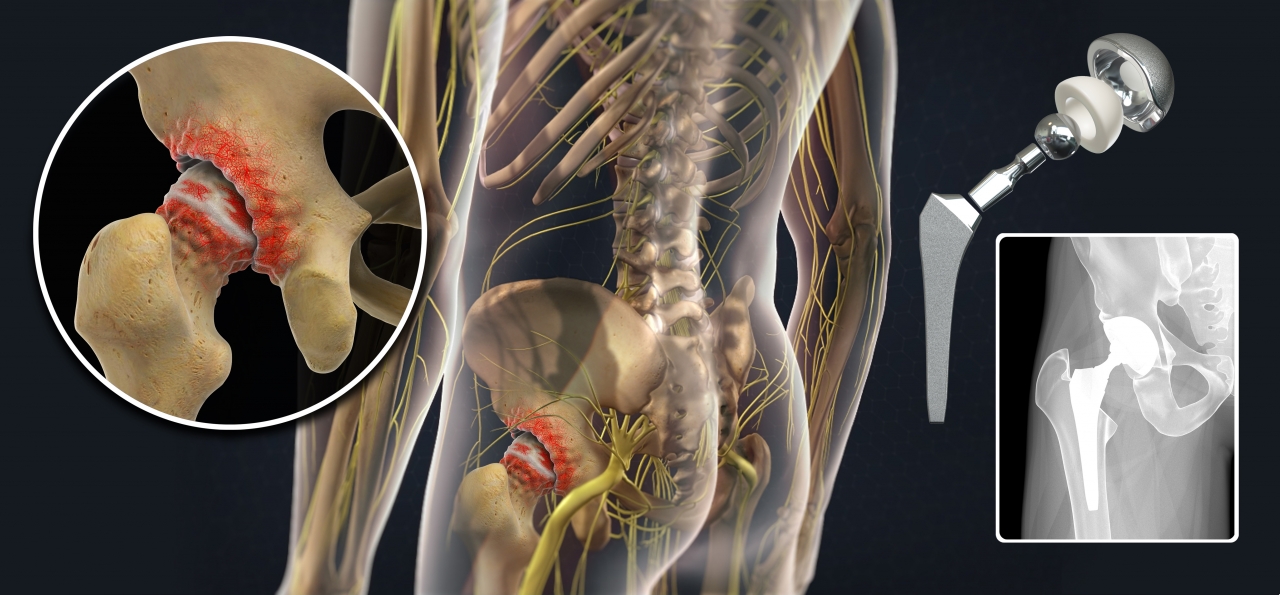Joint Replacement: Get Back in the Game – Broward Health North

Osteoarthritis is the most common form of arthritis affecting more than 25 million people. It is genetic and causes pain, stiffness and destruction within the joint. Common sites of osteoarthritis include the hip, knee, fingers and shoulders. Some patients develop post-traumatic arthritis, which is arthritis that develops months or years after a major injury or fracture in or around a joint. Other forms of arthritis include rheumatoid arthritis and psoriatic arthritis. These are inflammatory diseases which affect the lining of the joints and often affect multiple joints in the arms and legs.
Osteoarthritis symptoms can be managed by anti-inflammatory medicines such as ibuprofen and naproxen. Physical therapy can help maintain flexibility in the joint and can strengthen the muscles around the arthritic joint. At its most advanced stages, Osteoarthritis causes severe pain and stiffness. Once the pain interferes with your daily activities and is no longer responding to conservative treatment, surgery is the treatment of choice.
A recent patient was suffering from a weak knee for nearly 40 years after developing post traumatic arthritis and stiffness after two initial surgeries when he was in the military. He underwent a successful total knee replacement in 2019 using computer-assisted navigation. He participated in inpatient physical therapy and went home two days after surgery. Seven weeks after surgery, this patient has no pain in his knee, he has much better flexibility and has just returned from a two week hike in the Smokey Mountains. A successful total knee replacement has restored his quality of life.
Total joint replacement (TJR) is one of the most commonly performed, elective surgical procedures in the United States, and the volume of primary and revision TJR procedures has risen continuously in recent decades. According to PubMed.gov, hip replacements are projected to grow 71% by 2030 and total knee replacements are projected to grow 85%, by 2030.
Joint replacement or other surgeries are sometimes considered the “treatment of last resort” for people with osteoarthritis. Doctors frequently tell patients to wait as long as possible before joint replacement, but to get the best results, it should also not be delayed too long. How do you know when it’s time to seek joint replacement surgery?
If you’ve unsuccessfully attempted conservative treatment or if damage to the cartilage or bone is beyond repair, remember that joint replacement is proven to be safe and highly effective in the right patient. Dr. Janke says this is still often your best option. Newer techniques in the hip and knee can give patients excellent pain relief and improved function.
Talk with your doctor about the best options and long-term strategies for you and understand what’s available for your specific problem. Preserving your joints and your activities and lifestyle is the basis for a partnership that is best for you.
If you need an orthopedic surgeon near you, visit BrowardHealth.org/Find-Doctor. To learn more about Broward Health North’s Joint Replacement Center, call 954.712.4274.
https://pubmed.ncbi.nlm.nih.gov/30180053/
https://aaos-annualmeeting-presskit.org/2018/research-news/sloan_tjr/
Anterior Approach Benefits
The benefits of performing a hip replacement through an anterior approach include improving a patient’s quality of life, but goes a few steps further.
Click on the headings below to learn more about the different benefits of an anterior approach hip replacement surgery.
Reduced trauma and risk of hip dislocation after surgery
Obtain better leg lengths
One of the most common complaints after a hip replacement is that the leg with the replaced hip is longer. This is due to a lot of reasons. Some are due to patient’s anatomy, some are due to technical aspects of the surgery. When a patient is on their side for a posterior approach, their pelvis is not perfectly level and it is difficult to measure the patient’s legs during the operation and determine equal lengths.
The benefit of the anterior approach is that with the patient on their back during the operation we can easily make sure the pelvis and hip are level and measure our leg lengths. More importantly however, during the operation we are using small amount of live x-ray images which give us immediate pictures of the inserted hip replacement and we can better judge the length of the patient’s hip by comparing with their other side. We still may not be perfect, but we are definitely much more precise and usually within a few millimeters.
Smaller incision
No Post-Operative Restrictions
Hip precautions are recommendations that orthopedic surgeons discuss with patients before and after surgery. These only apply to patients who have a hip replacement through a posterior approach. These recommendations are to prevent patients from dislocating their new hip replacement which is one of the most common complications that can occur after a hip replacement.
The precautions start on the day of surgery when a pillow is placed between your legs for approximately the first 4-6 weeks whenever you are sitting or lying down. When you sleep, you have to sleep on your back with the pillow between your legs for the first 4-6 weeks.
In addition you are told to follow a 90-90 rule which means don’t bend your hips or knees beyond 90 degrees. You are also told not to cross your legs, turn your toes inward, or tie your shoes. You shouldn’t sit on low chairs or couches. To assist with these precautions, you are also recommended to get an elevated toilet seat so that when you sit down on the toilet, you don’t go beyond 90 degrees at the hip either when you sit or get up.
If you have your hip replaced by an anterior approach, none of these precautions apply. The risk of dislocation is almost eliminated and you don’t need that cumbersome pillow between your legs. You can sit or sleep in any comfortable position you like. You can cross your legs, tie your shoes, and you don’t need an elevated toilet seat.
Faster recovery with less pain
Rehabilitation is different because of the elimination of hip precautions, but also it is much faster. The rehabilitation is faster because the muscles are not traumatized during the approach to the hip.
Patients are able to get up and walk with the use of a walker much easier and most progress to a cane with 2 to three weeks. Patients are walking independently without the use of a cane typically by 4-5 weeks and then returning to their normal activities shortly there after. Normal activities resume at about 3 months.
This is in comparison to a posterior approach whereby patients are on walkers for almost the first 4 – 6 weeks, progress to cane for the next 3-4 weeks, then walk independently at about 10 weeks.
Q: So, why aren’t all orthopedic surgeons doing hip replacements through an anterior approach?
That is a good question with probably several answers. Most orthopedic surgeons were trained to do hip replacement surgery through a posterior approach in their residencies. Doing it that way works and has excellent results and some surgeons are reluctant to change. Drs. Janke & Naide are open to change, if they think it adds benefits to their patients.
Secondly, to learn the anterior approach means traveling to see other surgeons perform the operation, and practicing on cadavers. This takes time and money.
Thirdly, it does help to have the special table to do this operation. Not all hospitals are willing to purchase a table that costs nearly $100,000 dollars.
Lastly, it does take a little longer to perform the operation through the anterior approach, but not significantly. It has added anywhere from one hour longer, initially, to only about 15-20 minutes longer, now.
Anterior Approach Versus Traditional Hip Replacement
Hip replacement surgery is one of the most successful treatment options that we as orthopedic surgeons have to offer to our patients with arthritis of their hips. Patients complain of pain, limitation of motion, and an overall decrease in their quality of life.
Hip replacement surgery benefits patients by giving them a new lease on life by improving their quality of life– whether it involves dancing, sporting activities, exercising, walking, or even the simple things such as grocery shopping, dressing, or tying your shoes.
How A Traditional Hip Replacement Is Performed
Traditionally a hip replacement is done by a posterior or posterior lateral approach. The patient is positioned on their side on the operating room table. A 6 to 8 inch incision starting around the buttocks and curving around the outside of the hip is performed.
Then, the muscles of the buttocks are split followed by detachment of 4 other muscles from the back of the hip. The hip is then dislocated at which point, we can now access the hip socket and the upper part of the hip and perform the replacement.
During this time, we replace the ball of the hip with either a metal or ceramic ball with a stem that goes into the upper part of the thigh bone and then, place a new metal socket into the pelvis with a liner made of either a durable plastic material or ceramic.
We then repair the detached muscles to the bone, bring back the buttocks muscle that was split and then close the skin.
How An Anterior Hip Replacement Is Performed
The anterior approach is an exciting new technique that we are currently performing to replace a hip. Instead of the patient lying on their side for the operation, they lie on their back. We then make a small 4 inch incision just below and to the outside of the groin.
After the skin incision, 2 muscles are identified and then pushed aside. No muscles at any time during this procedure are split or detached. We then have clear access to the hip at which point, we perform the replacement. Again, the ball and socket are replaced with either a metal or ceramic ball with a stem that goes into the upper part of the thigh bone and then, place a new metal socket into the pelvis with a liner made of either a durable plastic material or ceramic.
After completion of the procedure, we don’t have to repair any muscles that were split or detached and the skin is closed.
Q: Is anterior hip replacement surgery minimally invasive?
No hip replacement is completely minimally invasive, because it is still a major operation. Any major operation that involves anesthesia, blood loss, cutting of bone, and exposing the joint carries a certain number of risks. However, an anterior approach to hip replacement surgery is definitely less invasive than a posterior approach because of the fact that we do not split, divide, or cut muscles.
Q: Is special equipment needed to perform anterior hip replacement surgery?
The procedure can be done without any special equipment, but it is very difficult to do it that way. We are using a special table called the Hana table. We are the only ones south of Gainesville who have this table. This table was specifically designed to allow orthopedic surgeons to perform anterior hip replacement surgery with greater ease.

- Patient positioned supine on Pro-FX table
Patient’s feet are placed in boots that look like ski boots for the operation – they are then positioned on the table on their back and then during the operation we are able to position the leg in almost any position to allow access to either the ball or socket of the hip joint. The table also comes with a special hook retractor that we use to elevate the thigh bone during the operation that allows us to prepare the thigh bone or upper part of the hip for the stem portion of the replacement.
We also use a fluoroscopy machine during the operation. This is an x-ray machine that gives immediate information during the operation to help obtain better leg lengths, but also to help us place the hip replacement in the most optimal position. This is important because an artificial hip put in the best optimal position will have a lesser chance of dislocation and a better chance of lasting longer, hopefully a patient’s lifetime.
Q: Is it more expensive and does my insurance cover anterior hip replacement surgery?
It does not cost the patient any more to do the operation through an anterior approach compared to the posterior approach and all insurances cover the procedure regardless of the approach.
Anterior Approach to Total Hip Replacement
Dr. Janke and Dr. Naide are among a very exclusive group of surgeons nationwide offering anterior approach to hip replacement surgery. They are the first – and most experienced – surgeons in South Florida who are specially trained and now performing anterior approach hip replacement surgery utilizing a specially designed Hana table. All together, the practice has performed 4,500+ anterior total hip replacements!
The anterior surgical approach, done with patients lying on their back, uses a small incision and avoids cutting of any muscles.
This approach allows for a more rapid recovery process and therefore a quicker return to normal activity. A patient’s recovery is further enhanced by the elimination of post-operative restrictions that are associated with traditional hip replacement surgery.
Benefits include:
- Quicker Return to Normal Activities
- No Post-Operative Restrictions
- Smaller Incision
- No Muscle Cutting
- Better Placement of Implants
- Faster Recovery
Another benefit of the anterior approach, is that the surgery is done with the patient lying on their back, and the incision is in the front of the hip. This allows us to use x-ray guidance in the operating room as well as computerized navigation. Both of these techniques allow for more accurate measurement of leg lengths at the time of surgery. Furthermore, with the intra-operative information gained from the x-ray or the computer, these help assure excellent placement of the implants.
Approximately 375,000 Americans undergo hip replacement surgery each year. This number is expected to almost double over the next 25 years due in part to the aging of the population. “Our goal, as orthopedic surgeons, is to reduce the debilitating pain from the arthritis and improve quality of life for our patients.” Utilizing the anterior approach with high quality hip replacement implants, our patients should expect a more rapid recovery with less restrictions.
It is important to realize that this is not a new technique. It has been done in Europe for many years with excellent results. The approach is somewhat technically demanding. The Hana table greatly aids in this approach. Patients interested in learning more about hip replacement surgery through the anterior approach can contact our office.


